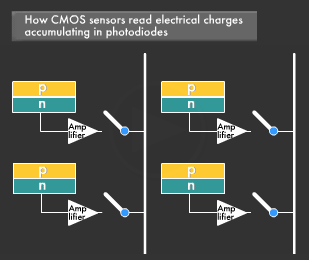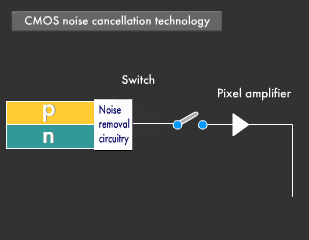Canon Science Lab
CMOS Sensors
Like CCDs, CMOS(Complementary Metal Oxide Semiconductor) sensors are semiconductor image sensors that convert light into electrical signals.
CMOS sensors are semiconductor light sensors like CCDs. They have much the same structure as the CMOS memory chips used in computers, but whereas memory chips employ row upon row of transistors to record data, CMOS sensors contain rows of photodiodes coupled with individual amplifiers to amplify the electric signal from the photodiodes. This structure not only enables CMOS sensors to operate on less electrical power than CCDs, but also enables speedier and easier reading of electrical charges. Moreover, unlike CCDs, the manufacture of which involves complicated processes that make them costly, CMOS sensors can be manufactured by modifying the relatively low-cost processes used to produce computer microprocessors and other chips.
The Structure of CMOS Sensors
Until recently, almost all digital camera image sensors were CCDs. The disadvantages of CCDs are that they require a lot of electrical power, and conversion of images to digital data is slow. This is why Canon began work on CMOS sensors, which have the same kind of structure as computer microprocessors and CMOS memory chips. Such chips contain large arrays of transistors, which in CMOS sensors are each composed of a photodiode and amplifier. The photodiodes accumulate electrical charge when exposed to light, and those charges are then converted to voltage, amplified and transmitted as electrical signals.

In CCDs, the gate structure used to transfer electrical charges to the edge of the sensor requires a separate power source, which means more electrical power is needed. However, CMOS sensors require only a single power source, and consume very little electrical power. They can also read off the electrical charges much more rapidly than CCDs.
Manufacturing High Resolution CMOS Sensors
The merits of CMOS sensors are not limited to their low voltage and electrical power consumption. They have the same basic structure as computer microprocessors, and can be mass produced using the same well-established manufacturing technology, making their production much less costly than that of CCDs. In the past, it was difficult to produce CMOS sensors with high pixel counts, but this shortcoming has been overcome through the development of new semiconductor manufacturing technologies. One such technology involves a multiple-exposure process to create the sensor's circuitry, enabling the manufacturing of large CMOS sensors with a high resolution of 20 megapixels.

CMOS Noise Cancellation Technology
CMOS sensors generally have the disadvantage of generating electrical noise, which can result in poor image quality. There are unavoidable fluctuations in the performance of over ten million photodiodes and amplifiers incorporated into a CMOS sensor, and the tiny differences in performance result in noise in the output image. To overcome this problem, Canon developed on-chip technology to record the noise of each pixel before exposure, and automatically subtract such noise from the image when it is created.

The addition of noise removal enables the reading of a noise-free signal. Furthermore, the elimination of remaining quantum random noise is made possible by another technology known as complete electronic charge transfer.
